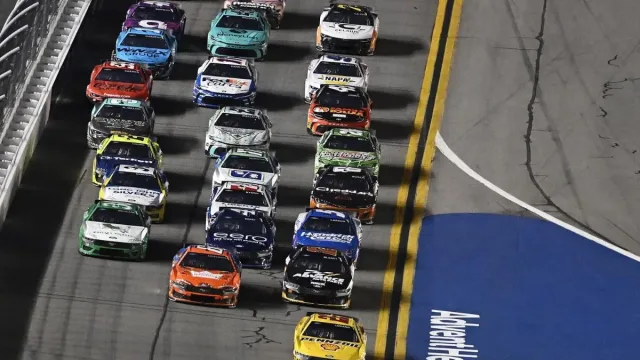The 2025 NASCAR Cup Series makes history with its inaugural points race at the Autódromo Hermanos Rodríguez in Mexico City. As anticipation builds for this landmark event, teams, drivers, and fans are closely monitoring a wildcard that could dramatically impact the outcome: the weather. With forecasts oscillating between cloudy skies and the threat of rain, the race weekend is shaping up to be a true test of adaptability, strategy, and nerves.
Weather Forecast: Uncertainty Looms Over Mexico City
The weather for NASCAR’s Mexico City weekend is anything but settled. Multiple forecasts paint a picture of a potentially wet and wild event. While some sources indicate a relatively low chance of precipitation—around 10–16% for Sunday’s Cup race—others warn of scattered thunderstorms and a 70% chance of rain by race time. The inconsistency in these predictions reflects the volatile weather patterns typical of Mexico City’s high-altitude climate.
Friday and Saturday are expected to be mostly cloudy, with highs in the low to mid-70s Fahrenheit and a moderate breeze from the east. The chance of rain is present but not dominant, though the possibility of afternoon thunderstorms on Saturday adds another layer of uncertainty. For Sunday, the main event, clouds are expected to persist, and while most forecasts suggest a mild chance of rain, the possibility of a downpour cannot be ignored—especially given the region’s reputation for sudden weather changes.
This unpredictability places additional pressure on teams to be ready for any scenario, from dry conditions to a full-fledged rain race, and everything in between.
 Cook Out Clash 2025 Prize Money” width=”1200″ height=”800″ srcset=”https://slicksandsticks.com/wp-content/uploads/2025/01/Cook-Out-Clash-2025-Prize-Money.webp 1200w, https://slicksandsticks.com/wp-content/uploads/2025/01/Cook-Out-Clash-2025-Prize-Money-300×200.webp 300w, https://slicksandsticks.com/wp-content/uploads/2025/01/Cook-Out-Clash-2025-Prize-Money-1024×683.webp 1024w, https://slicksandsticks.com/wp-content/uploads/2025/01/Cook-Out-Clash-2025-Prize-Money-768×512.webp 768w, https://slicksandsticks.com/wp-content/uploads/2025/01/Cook-Out-Clash-2025-Prize-Money-630×420.webp 630w, https://slicksandsticks.com/wp-content/uploads/2025/01/Cook-Out-Clash-2025-Prize-Money-150×100.webp 150w, https://slicksandsticks.com/wp-content/uploads/2025/01/Cook-Out-Clash-2025-Prize-Money-696×464.webp 696w, https://slicksandsticks.com/wp-content/uploads/2025/01/Cook-Out-Clash-2025-Prize-Money-1068×712.webp 1068w” sizes=”auto, (max-width: 1200px) 100vw, 1200px” />
Cook Out Clash 2025 Prize Money” width=”1200″ height=”800″ srcset=”https://slicksandsticks.com/wp-content/uploads/2025/01/Cook-Out-Clash-2025-Prize-Money.webp 1200w, https://slicksandsticks.com/wp-content/uploads/2025/01/Cook-Out-Clash-2025-Prize-Money-300×200.webp 300w, https://slicksandsticks.com/wp-content/uploads/2025/01/Cook-Out-Clash-2025-Prize-Money-1024×683.webp 1024w, https://slicksandsticks.com/wp-content/uploads/2025/01/Cook-Out-Clash-2025-Prize-Money-768×512.webp 768w, https://slicksandsticks.com/wp-content/uploads/2025/01/Cook-Out-Clash-2025-Prize-Money-630×420.webp 630w, https://slicksandsticks.com/wp-content/uploads/2025/01/Cook-Out-Clash-2025-Prize-Money-150×100.webp 150w, https://slicksandsticks.com/wp-content/uploads/2025/01/Cook-Out-Clash-2025-Prize-Money-696×464.webp 696w, https://slicksandsticks.com/wp-content/uploads/2025/01/Cook-Out-Clash-2025-Prize-Money-1068×712.webp 1068w” sizes=”auto, (max-width: 1200px) 100vw, 1200px” />
Technical and Strategic Challenges in the Face of Rain
Rain at a road course like Autódromo Hermanos Rodríguez introduces a host of technical and strategic variables not typically seen in NASCAR’s oval-dominated schedule. Unlike short tracks, where wet-weather tire rules are more restrictive, road courses allow for greater flexibility. If rain is present before the green flag, teams are permitted to roll off on either dry (“slicks”) or wet-weather tires for the parade lap, and can then choose which compound to start the race on without penalty.
Once the race is underway, tire strategy is entirely in the hands of the crew chiefs and teams. Decisions about when to pit for fresh tires—dry or wet—can make or break a race. The Autódromo’s slick surface, combined with the altitude (over 7,500 feet above sea level), means that grip levels can change rapidly as the track dries or gets wetter. Teams must be prepared to adapt on the fly, making split-second calls that could vault them to the front or send them tumbling down the order.
The high altitude also affects engine performance and cooling. At such elevations, engines produce less horsepower and cooling systems are less efficient, as water boils at a lower temperature. Add rain to the mix, and teams face a unique technical puzzle: how to maximize grip, manage engine temperatures, and keep their drivers competitive in conditions that are rare for NASCAR’s usual circuits.

The Spectacle and Significance of a Rain Race
A wet race in Mexico City would not only test the skill and adaptability of the drivers and teams, but also create a spectacle for fans. Rain races are rare in NASCAR, especially at road courses, and tend to produce chaotic, unpredictable action. The 2023 Chicago Street Race, which was won by Shane van Gisbergen in his Cup Series debut, showcased how rain can level the playing field and produce surprise winners.
For the Mexico City event, a rain race would further underscore the global nature of NASCAR’s expansion. It would highlight the sport’s ability to adapt to new environments and conditions, and provide a memorable experience for both longtime fans and newcomers. The unpredictability of the weather would add an extra layer of drama, ensuring that every lap could bring a new twist to the championship narrative.
Moreover, a wet race would put NASCAR’s new wet-weather tire rules to the test. Teams would have to make crucial decisions about tire selection and pit strategy, while drivers would need to manage their cars carefully on a slippery surface—skills that are not always in high demand on ovals.
Chevrolet-Faces-Growing-Criticism-in-NASCAR.webp” alt=”Chevrolet Faces Growing Criticism in NASCAR” width=”1200″ height=”800″ srcset=”https://slicksandsticks.com/wp-content/uploads/2025/01/Chevrolet-Faces-Growing-Criticism-in-NASCAR.webp 1200w, https://slicksandsticks.com/wp-content/uploads/2025/01/Chevrolet-Faces-Growing-Criticism-in-NASCAR-300×200.webp 300w, https://slicksandsticks.com/wp-content/uploads/2025/01/Chevrolet-Faces-Growing-Criticism-in-NASCAR-1024×683.webp 1024w, https://slicksandsticks.com/wp-content/uploads/2025/01/Chevrolet-Faces-Growing-Criticism-in-NASCAR-768×512.webp 768w, https://slicksandsticks.com/wp-content/uploads/2025/01/Chevrolet-Faces-Growing-Criticism-in-NASCAR-630×420.webp 630w, https://slicksandsticks.com/wp-content/uploads/2025/01/Chevrolet-Faces-Growing-Criticism-in-NASCAR-150×100.webp 150w, https://slicksandsticks.com/wp-content/uploads/2025/01/Chevrolet-Faces-Growing-Criticism-in-NASCAR-696×464.webp 696w, https://slicksandsticks.com/wp-content/uploads/2025/01/Chevrolet-Faces-Growing-Criticism-in-NASCAR-1068×712.webp 1068w” sizes=”auto, (max-width: 1200px) 100vw, 1200px” />
News in Brief: NASCAR Mexico City Weather
As NASCAR embarks on its first points race in Mexico City, the unpredictable weather forecast looms large over the event. The potential for rain introduces a host of technical, strategic, and dramatic elements that could define the weekend. Teams and drivers must be prepared for anything, from dry and sunny conditions to a rain-soaked battle of wits and reflexes.
The Autódromo Hermanos Rodríguez’s unique challenges—its altitude, its slick surface, and the ever-present threat of rain—will test every aspect of NASCAR’s adaptability and innovation. For fans, the uncertainty adds to the excitement, promising a race that could be remembered for years to come. Whether the skies open up or stay dry, one thing is certain: NASCAR’s return to international competition is set to be a landmark moment, shaped in no small part by the whims of the weather.
ALSO READ: NASCAR’s In-Season Tournament Kicks Off: $1 Million Prize on the Line in Historic Bracket Format
